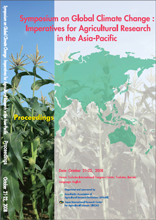Coping with climate change in the Semi-Arid Tropics

Most climate change models suggest rise in temperatures, sea levels, and extreme weather
events leading to unprecedented changes in various sectors, including agricultural production in the
future years. Both developed and developing countries are affected, but developing countries with
little adaptive capacity and limited resources are more vulnerable to climate change effects.
Desertification, fresh water shortages, soil erosion, increased salinity, changed pest and disease
scenario, biodiversity loss, reduction in length of growing period are some of the consequences that
adversely affect the agricultural productivity straining the national economies. Detailed implications of
climate change effects, resilience of populations and coping mechanisms are not fully understood in
most countries in semi-arid tropics (SAT) of Asia and Africa 1, 2. ICRISAT, with the help of partners,
is working to better understand the global, national and regional impacts of climate change on
agricultural production and resource management and developing mechanisms to better cope up with
the climate change effects in the semi-arid tropics (SAT) of Africa and Asia1.
ICRISAT has developed an operational research strategy (ORS) (2008─2015) entitled
“Adaptation to and mitigation of climate change in the semi-arid tropics”. This strategy addresses key
climate change adaptation challenges, through two major strategic initiatives designed for short-tomedium
term and medium-to-longer term2.
? Short-to-medium term: Helping farmers and their support agents to cope better with current
rainfall variability as a prerequisite to adapting to future climate change.
? Medium-to-longer term: Adapting our mandate crops (sorghum, pearl millet, pigeonpea,
chickpea and groundnut) to grow in a warmer world.
Productivity uncertainty associated with between and within season rainfall variability remains a
fundamental constraint in SAT areas. Climate change is likely to make matters worse with increases in
rainfall variability being predicted for the SAT region. ICRISAT believes that the ability of
agricultural communities and agricultural stakeholders should first be enhanced to enable them to cope
better with the constraints and opportunities of current climate variability if they are to be in a position
to adapt to the predicted future increases in climate variability. Developing better forecasting methods,
improved management practices and capacity enhancement of stakeholders is given priority in the
short- to medium-term.
ICRISAT has identified medium term priority strategies that will result in crop varieties and
cropping systems that are adapted to a changed environment. Key factors considered in ICRISAT’s
Integrated Genetic and Natural Resources Management (IGNRM) strategies are2:
? Higher temperature tolerance.
? Increased root stress due to drought, soil salinity, acidity, nutrient availability and flooding.
? Changed severity and distribution of pests and diseases.
? The migration of our mandate crops into geographical areas already marginal for crops
currently being grown there.
The IPCC climate model projections suggest an increase in global average surface temperature
of between 1.4 and 5.8°C from 2001 to 2100, the range depending largely on the scale of fossil-fuel
burning between now and then and on the different models used. However, broad trends will be
overshadowed by local differences, as the impacts of climate change are likely to be highly spacially
variable3. How to cope with climate change effects?
There is no silver bullet to address the impacts of climate change effects. Adaptation is
important, but it alone cannot help coping with climate change effects. Adaptation and mitigation
should go hand-in-hand. A blend of adapted cultivars, improvement natural resource management
technologies, better forecasting methods, knowledge sharing and market intelligence help overcoming
the climate change effects in agricultural production. On-farm testing of technologies and village level
studies on coping mechanisms give valuable information for shaping research programs and capacity
enhancement. Climate policy is critical in shaping the coping mechanisms. However, climate
outcomes will be influenced not only by climate-specific policies but also by the development path
chosen4. Asia and Africa, which are already experiencing the adverse impacts of climate change,
cannot afford to “wait and see” or follow the historic, unsustainable, carbon-intensive development
path of industrialized countries. Climate change mitigation and adaptation policies need to be
integrated with sustainable development policies.
The road map for future
As indicted earlier, there is no ‘silver bullet’ for all climate change problems. A combination of
adapted cultivars, improved management practices, better forecasting methods, policy initiatives and
knowledge sharing mechanisms contribute to better coping with climate change effects. IARCs and
ARIs need to prioritize the efforts in this direction taking the NARS and other stakeholders on board.
Falling agricultural yields would block the development and heighten poverty, thereby increasing the
risk of conflicts across the globe. ICRISAT, with the climate resilience of its mandate crops; past work
and on-going efforts with the new operational research strategy internalized along with the policy
research is well positioned to support the smallholder farmers in SAT regions of Africa and Asia.
| 刊行年月日 | |
|---|---|
| 作成者 | C L Laxmipathi Gowda William D. Dar A Ashok Kumar |
| 著者キーワード |
Climate change Semi-Arid Tropics Crop modeling Crop adaptation Mitigation |
| 公開者 | Japan International Research Center for Agricultural Sciences |
| オンライン掲載日 | |
| 号 | 2008 |
| 開始ページ | 136 |
| 終了ページ | 142 |
| 権利 | Japan International Research Center for Agricultural Sciences |
| 言語 | eng |
